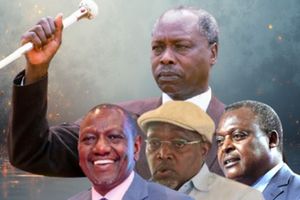Premium
Kenya protests explained: Why are people demonstrating?

Supporters of politician Raila Odinga, leader of the Azimio la Umoja Ona Kenya Coalition, during anti-government protests in the Bangala area of Mombasa County on March 20, 2023.
The opposition leader in Kenya, Mr Raila Odinga, has successfully managed to mobilise his supporters to paralyse normal operations in Kenya’s capital, Nairobi.
The areas that have been hugely hit by the demonstrations include Kisumu town, Homa Bay town, and some of the areas in Nairobi’s estates such as Kibra constituency.
But what is this bone of contention that has led to this chaotic Monday, which has been dubbed #Maandamano?
Well, since the former Independent Electoral and Boundaries Commission (IEBC) chairperson Mr Wafula Chebukati announced Dr William Ruto as the President-elect on August 15, 2022, the Azimio La Umoja one Kenya Coalition led by Mr Odingaa disagreed with the final results.
That was the beginning of the politics of defiance, where Azimio failed to recognise the legitimate government of President Ruto.
The Azimio challenged the outcome at the Supreme Court, a case that they lost for failing to table enough evidence.
However, days later after the Supreme Court made its pronouncement regarding the presidential election, Mr Odinga emerged with a fresh controversy claiming to have won the election following what he called a leaked dossier from an IEBC whistleblower.
Mr Odinga, quoting an unofficial dossier said that he emerged the winner after garnering 8,170,355 votes ahead of President Ruto who reportedly gained 5,919,973 votes.
Now, Mr Odinga wants the IEBC’s server to be opened to know how the final results were reached, where President Ruto garnered 7,176,141 against Mr Odinga’s 6,942,930 votes.
The second condition of Mr Odinga that has culminated to protest is the ongoing process of recruiting IEBC commissioners.
Mr Odinga has blamed the President for solely carrying out the process of recruiting new commissioners, and has demanded the process be stopped
According to him, if the process continues, voter apathy could be witnessed in the 2027 general election if the issues surrounding IEBC are not addressed.
“Cameroon has had a voter turnout of fifteen per cent in recent elections, we will be lucky to reach forty per cent in 2027,” Mr Odinga told the media in his recent address.
Also, Mr Odinga has blamed the Kenya Kwanza Alliance administration for failing to lower the cost of living seven months after being in power.
He urged the President to bring back subsidies as was the case with the last regime of Mr Uhuru Kenyatta.
Mr Odinga acknowledged that the cost of living is currently high all over the world, but some countries such as the US, Brazil, and India have introduced subsidies.
"We are telling Ruto to bring back the subsidies so that Kenyans can get a sigh of relief," Mr Odinga said.
However, the President has said that the cost of living will go down in a few months, saying that his government has put in place measures to lower the price of unga, a min commodity that is being used by Kenyans.
Currently, 2kg of cooking flour retails at Sh200, and the government has promised to bring it to Sh140.





